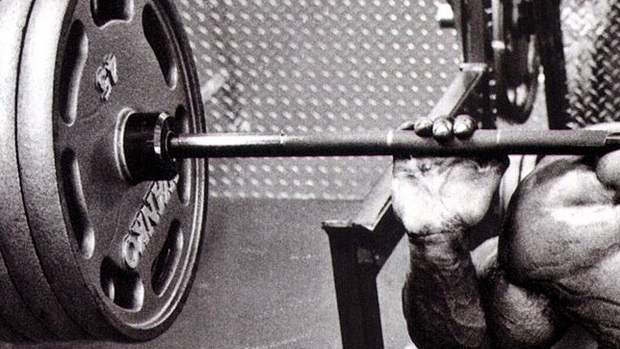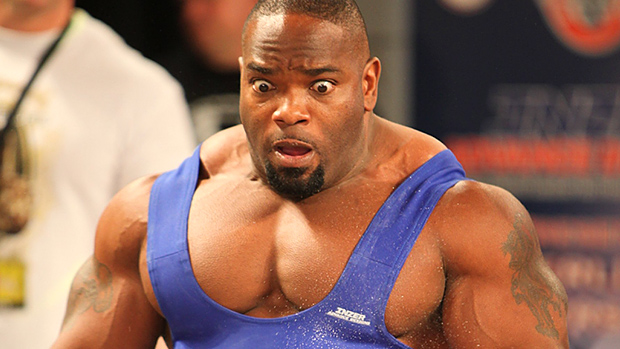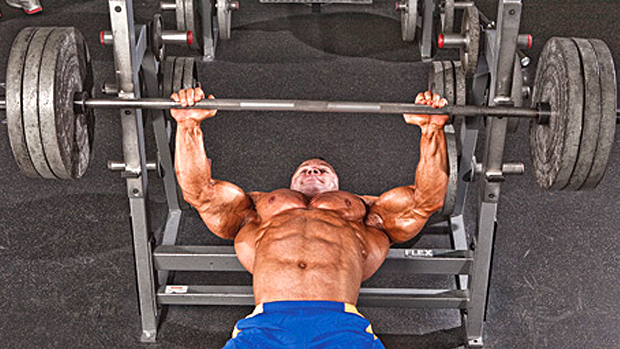Are you using the right squat for your strength goals? Let's compare and contrast the primary barbell versions of the squat: the low-bar squat, the high-bar squat, the front squat, and the overhead squat.
The low-bar squat, performed with a moderate stance and below-parallel depth, yields the largest systemic stress and thus the greatest general strength increases. It's the default squat of choice for general strength training.
Although the squat is often considered a quads exercise by bodybuilders or a knee-dominant movement pattern by "functional training" experts, the low-bar squat version of the exercise is really best thought of as a total body movement with focus on the hips. Some lifters don't think the low-bar squat works the quads, though. We can easily dismiss this by pointing out that if you flex your knee on the way down and then extend it against the load on the way up, your quads are the only muscles that significantly contribute to this knee extension.
Some of the confusion regarding the low-bar squat and quads may revolve around a style of squatting often employed primarily, though not exclusively, by geared powerlifters – those who compete in heavy wraps and suits. This squat style utilizes a very wide stance and a vertical shin with very little knee bend. If you've ever been to a meet with lifters using multi-ply equipment, you'll surely have heard coaches calling out for their lifters to go, "Back! Back! Back! Back!" The fact that "Back!" is used as the exclusive cue is instructive. The lifters are thinking solely about sitting back, with vertical shins. The way many lifters do box squats reinforces this movement pattern, which places the load almost entirely on the hip and back musculature, aided by the gear.
And to the extent the knees do flex and extend, the extension is aided by heavy-duty knee wraps which store elastic energy on the way down and release it on the way up, contributing to the lift and potentially reducing the amount the quads work. A squat style like the one below, done exclusively without any below parallel squat training, might under develop the quads.

Note the shin angle appears to be vertical when viewed from this angle, with the open knee angle indicating a lower degree of quad involvement. Notice the depth. Also note the weight – 935. This is a very strong man, but it doesn't necessarily follow that this style of squatting is the best way to develop generalized strength.
However, the recent surge in popularity of raw powerlifting and general strength training has brought a much more moderate form back into vogue: squats walked out, heels about shoulder width apart, and to below-parallel depth. So we don't squat to "work the quads," we squat to get stronger (bodybuilders and physique competitors sometimes excepted).
Reasons to Do the Low-Bar Squat

The low-bar squat utilizes a tremendous amount of muscle mass over a long range of motion and allows the lifter to handle more weight than the other variants, thus providing the largest training effect of the four versions.
The high-bar squat can be used very effectively for general strength training (though less effectively than the low-bar squat) or for other specific applications that an injured lifter may need.
Beloved by Olympic weightlifting coaches, the high-bar squat is also the way you'd squat if no one gave you any other specific instruction. You wouldn't walk up to the bar and put it in a front rack, or press it overhead with a snatch grip, or hold it in the crook of your elbows. You wouldn't even get under it so it rested just below your scapular spine on top of your rear delts. Nope. You'd put it on your traps and take it out that way. The high bar squat seems to be the most intuitive way to do the lift.
The high-bar squat is characterized by a more upright, vertical torso than the low-bar squat. Since every squat requires the bar to stay in balance over the middle of the foot (at least when you use heavy weights; you're free to do whatever you like when it's light), the more vertical back angle means the knees must shift farther forward to keep the bar over mid-foot.
The knee angle is thus more closed at the bottom of the movement. This leads to more of the work (as a percentage of the load) being shifted to the quads and less to the hamstrings. However, since the torso isn't as vertical as in the front squat and since the bar isn't carried on the front delts, more weight can be lifted in the high-bar squat than the front squat, leading to an intermediate between the low-bar squat and front squat when it comes to load lifted, systemic stress, and strength adaptation response.

The image above clearly illustrates the differences in back angle and the resultant differences in moment arm (the length between the joint axis and the line of force acting on that joint) at the knee and hip between the low bar, high bar, and front squats.
Reasons to Do the High-Bar Squat
The high-bar squat is the go-to option if the low-bar squat can't be performed for some reason. Excessively tight shoulders, whether structural or due to a lack of mobility, are the most common culprit. Structural problems can't really be fixed, but mobility problems can certainly be fixed with consistent mobility/flexibility work. The high-bar squat may be used as an assistance variation for more advanced lifters. Sometimes variation is a good tool to stay motivated to train through a hard session without getting bored. While this may sound trivial, it may be a legitimate issue for people who squat multiple times per week for many years. If you're still within your first few years of training, you're still working on your fundamentals, and employing variation solely to alleviate boredom is likely a cop-out from doing the hard work that you don't want to do.
And, much to the surprise of many who are critical of the principles of the book Starting Strength, it's obvious that the high-bar squat is an effective way of squatting as general strength preparation for Olympic weightlifting. Just look at the fact that almost every successful Olympic lifter in history has used the high-bar squat as the primary heavy squat variant in training.
The front squat is absolutely necessary for Olympic weightlifters. It can also be used effectively for general strength training, though not as effectively as either the high-bar or low-bar squat. It has useful applications to advanced lifters as well, in various cycles of training.
The front squat departs from the high-bar and low-bar squats in that the bar is carried in the rack position on the meat of the deltoids, which are bunched up by raising the elbows. It's trapped in place by the hands and fingers, but the weight of the bar is supported by the delts and torso.
Since the bar must stay over mid-foot at heavy weights, an extremely vertical/upright torso is required in the front squat so as not to lose the bar forward and have to dump it. The torso is even more upright here than in the high-bar squat, leading to an even more forward knee position. This closed knee-angle shortens the hamstrings even more than in the high-bar squat, limiting their contribution in the movement. Additionally, an even larger moment arm between knees and bar and shorter distance between hips and bar ensure that the quads do a larger percentage of the work here, and the posterior chain less so.
The front squat also works the thoracic erectors to a greater extent than the low-bar or high-bar squat. Depending upon the depth of the lifter's chest and thorax, there can be quite a long moment arm between the bar and the t-spine erectors, causing them to do a lot more work to keep the torso rigid and upright, as is necessary for force transmission and to avoid leaning forward and dumping the bar. In both back squat variants, there's virtually no moment arm at the thoracic erectors.
The glutes also get a large share of work here even though the moment arm against them is shorter than the high-bar and low-bar squats, due to the lack of availability of the severely shortened hamstrings to help extend the hip. This is one of the reasons your glutes get so sore when you front squat heavy, but don't when you low bar squat heavy, despite the significantly greater load on the bar in the low-bar squat.
Reasons to Do the Front Squat
The main use of the front squat is as a necessary assistance exercise for an Olympic lifter. It mimics the catching and recovering position of the clean, but can be done under conditions of greater control by taking it out of the rack, which allows the use of more weight. This advantage in loading allows strength to be developed that otherwise couldn't if all front squats were only done as clean recoveries, and this strength directly carries over to the clean itself, for obvious reasons.
The front squat can also be used for people who can't back squat for some reason, or as a general strength builder. Though it should hopefully be apparent by now that as a general strength builder, useful as it is, the front squat is still inferior to both the high-bar and low-bar squat due to the lower weight that must be used and the resultant lower systemic stress.
It may also be used as an assistance lift to get more focused quad, thoracic erector, or abdominal work into the movement while not stressing the system as much as a heavier low-bar squat, which needs a longer recovery period. This isn't to say the front squat is easy. If you've read this far and are still not differentiating between "easy" and "systemic stress," you might want to start over and read more slowly.
The overhead squat has a lot in common with the low-bar squat, but because it necessitates such a drastic reduction in load, it's a weaker choice for general strength training.
The overhead squat (OHS) is similar to the front squat in that it's the position assumed when an Olympic lifter recovers from the snatch. However, it's very different in that the degree of torso lean is highly variable. Because the bar is held locked out at arms-length overhead, the shoulders can go deeper into flexion to account for a more horizontal torso and they can be placed less into flexion for a more upright torso position at the bottom.
Another significant difference between the overhead squat and the front squat is the recovery. At the bottom of, and throughout the front squat, the torso must remain upright or else the bar will get too far forward of the mid-foot balance point and be lost forward. This applies to both the front squat done out of a rack and recovery from the clean. By contrast, in a heavy overhead squat and snatch, even when the bar is caught or brought down with a vertical torso, there's a noticeable back angle change out of the bottom and the hips are used as the primary driver out of the hole.
The great Chinese 77kg lifter, Lu Xiojun, catches this 175kg snatch here:

Yet by the time he's risen to just below parallel, his back angle has changed significantly to the horizontal:

If those angles of the knee, hip, and back look familiar, it's because they're exactly what you'd expect to see if Lu were performing a low-bar squat.
Reasons to Do the Overhead Squat
At first glance, it would seem obvious that much the same as the front squat is used by Olympic lifters to train for strength specific to recover from the clean, the overhead squat should be used to train for strength specific to recovering from the snatch. However, many Olympic lifting coaches feel that it doesn't really need to be trained as its own lift (at least beyond an introductory phase), since squat strength is never the limiting factor in an overhead squat and squat strength is already covered by the other squatting the lifter is doing.
For CrossFitters, the overhead squat is used often in CrossFit WODs and has even been used in the Games, so if you're a competitive CrossFitter, it makes sense to train it for that purpose, and not necessarily only in complexes. However, the stress it places on the lifter's wrists when done heavy is enough to suggest that it's best used sparingly as plenty of snatching, complexes, and other squatting is presumably already being done.
For the general strength trainer, the overhead squat is more a display of total body strength and mobility but not a really great developer of it, due to the significantly reduced load that must be used compared to the low-bar squat, high-bar squat, and even the front squat. Is it useless? No one would suggest that. But when we're looking for the most efficient tool for the job, the other squat variants (especially low-bar) are better developers of squat strength, and the Olympic lifts themselves train and develop the total body control and mobility that the overhead squat requires.




